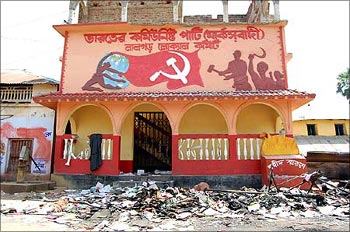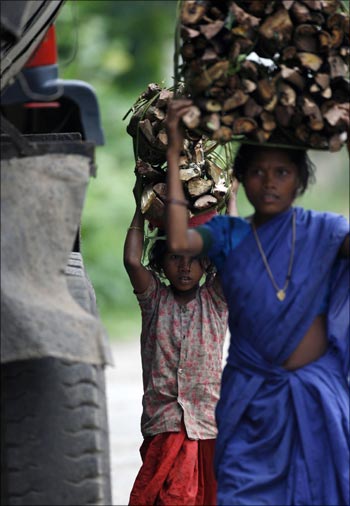 | « Back to article | Print this article |
Land acquisition: How it fuels the Naxal movement
In June this year, Naxalites, as Communist extremists are called in the country, pumped several bullets into Vimal Meshram, the 42-year-old head of the Lohandiguda panchayat in the Bastar region of Chhattisgarh. He died on the spot.
Meshram had supported Tata Steel's proposed 5.5 million tonnes per annum steel project in the region. He had actively campaigned for the plant and even negotiated with the villagers to give up their land.
Meshram, said a senior cop, had drawn the ire of the Naxalites for misappropriation of the money that was to be distributed to the people displaced by the steel project.
The murder, carried out in broad daylight in front of almost 10,000 people, and other such incidents have driven home the message.
Chhattisgarh has decided to go slow on land acquisition. Tata Steel had inked the deal in June 2005 but is yet to get 2,044 hectares of land it was promised, 84 per cent of which is farm land.
Click NEXT to read on further. . .
Land acquisition: How it fuels the Naxal movement
The state has claimed that most of the 1,707 displaced families have been compensated for their land. But Chitranjan Bakshi, the state secretary of the Communist Party of India, said it is just the outsiders have been paid; the tribes, the real sons of the soils, have not been paid.
Bakshi said he expects more trouble when the state government functionaries will come in a month or so to take possession of the land.
These problems, in more ways than one, capture the mess over acquisition of tribal land in the mineral-rich belt of the country.
States like Orissa, Chhattisgarh, West Bengal and Jharkhand have signed deals with companies for investments running into hundreds of thousands of crores (billions).
The states have said that this alone will bring prosperity to the poverty-ridden region, though their detractors have alleged that the administration is hand-in-glove with industry to grab the mines.
At the local level, resentment has risen over the rampant corruption in payment of money for tribal land, acquisition of arable land (half the land sought to be acquired for industry in Orissa, for instance, happens to be farmland) and lack of any support for resettlement of the displaced.
Land acquisition: How it fuels the Naxal movement
This has provided a fertile breeding ground for Naxalites. The confrontation with the state has brought to the fore the decades of neglect people of the region have faced.
The infrastructure in the region is a pale shadow of the rest of the country. Civic amenities exist only on paper. Prime Minister Manmohan Singh has described it as the biggest threat to the country's internal security, though he has acknowledged the need to accelerate development efforts.
Home Minister P Chidambaram has launched a massive ground offensive to cleanse the area of all Naxalites.
The numbers tell the story. In 2001-02, the total investment proposed in Orissa stood at Rs 100,000 crore (Rs 1,000 billion); today, it stands at Rs 600,000 crore (Rs 6,000 billion).
Eight years back, only three of the 30 districts in the state were affected by Naxalites. Today, they have spread their influence across as many as 20 districts. The festering wounds suffered by the tribes are ready to burst.
Land acquisition: How it fuels the Naxal movement
The land sought to be acquired from the tribes, to be sure, is huge. The 171 projects earmarked for Orissa require 118,715 acres, of which 43,214 acres have been acquired.
Chhattisgarh has promised 74,836 acres to industry, though less than 5 per cent has so far been bought. Jharkhand needs to arrange 98,547 acres for 55 industrial units. West Bengal needs to set aside 23,590 acres for ten steel mills.
Naturally, the displacement numbers are huge too. In Orissa, for instance, 32,443 families have already been displaced, though almost two-thirds of the land acquisition is yet to be done.
Eighty per cent of these families got displaced before the state could put in place its rehabilitation & resettlement policy in 2006. Even the new policy has failed to instill confidence in the tribes.
"People are not willing to leave their land in favour of a project as they do not have any trust on the government's policy and fear that parting with the land will bring them more misery,'' said Tapan Padhi, an activist in Orissa.
Land acquisition: How it fuels the Naxal movement
Around 1.5 million people, according to him, have been displaced by various industrial projects in the state since 1951.
Most other states have no idea how many have been displaced. Jharkhand has asked industry to buy land directly from the tribes because the state does not own much land.
About 20 companies have begun to do so. Though the state has washed its hands off the dirty job, it has caused another problem: The state has no record of people displaced by these companies!
And now West Bengal and Chhattisgarh also want industries to buy land for projects directly from farmers and tribes.
The scale of land acquisitions has made it easy for Maoists to sell the conspiracy theory to masses. ''The present war waged by the Indian rulers in Lalgarh, Dandakaranya, Jharkhand, Bihar, Orissa and elsewhere is a war for the plunder of the vast mineral wealth lying in the Adivasi regions," a recent Naxalite bulletin said.
The portents are ominous.
(With R Krishna Das in Raipur, Tapan Chakravorty in Ranchi, Dillip Satapathy in Bhubaneswar, Shashikant Trivedi in Bhopal, B Krishna Mohan in Hyderabad, Ishita Ayan Dutt in Kolkata, Maulik Rajnikanth Pathak in Ahmedabad and Sreelatha Menon in New Delhi)





